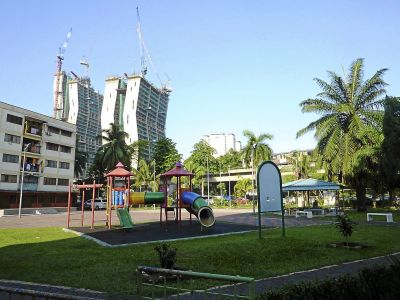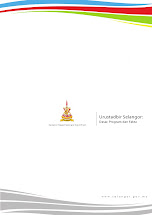http://www.starproperty.my/index.php/articles/property-news/study-approved-plan-before-buying-house/
Study approved plan before buying house
Buyers Beware By CHANG KIM LOONG

Provision of open and green spaces. The approval governs on how these open spaces allotted for the designated community activities such as playground for children, communal park, etc are to be used.
FIRST off is the regulation which is below.
It is mandated in the Preamble of Schedule G (landed property) of the standard sale and purchase agreement pursuant to Housing Development (Control and Licensing) Act 1966 and Housing Development (Control and Licensing) Regulations 1989, sub-regulation 11(1) that the vendor which is known as the “developer” to the masses has to provide as part of the legal documents, among others, the “approved” layout plan (to be annexed as the First Schedule) and approved building plan (to be annexed as the Second Schedule).
Similarly, Schedule H (Stratified Property) requires attachment of the “approved” 1: Site plan, 2: Layout plan, 3: Floor plan of the said parcel, 4: Storey plan of the said building (delineation of the said land comprising the said parcel), 5: Accessory parcel plan, and 6: Common facilities plan (to be collectively annexed as the First Schedule) and approved building plan (to be annexed as the Second Schedule).
This mandatory requirement has been entrenched within the Housing Development Regulations and the statutory sale and purchase agreement but has gone unnoticed by the regulatory body i.e. the Housing and Local Government Ministry and its enforcement agencies.
Why is it so important for these approved drawings to be made part of the contract obligation and condition?
There has been no shortage of complaints from the purchasers over the years on the deviations found in their end-products i.e. their completed unit of stratified apartment/condominium or landed residential house and their surrounding habitat from those represented in the sale brochure, flyers and even plans attached to the standard sale and purchase agreement signed between them and the developer.
The importance of these plans/drawings document are best described through the following scenarios.
·Development of open space/future development
Purchasers ought to be aware that modern living these days involves more than purchasing a piece of subdivided land/a piece of strata apartment/condominium in the air in a scheme. What one is actually purchasing is a concept of living style which apply to all ends of the market, from low, medium cost to the high notch end, which means its surrounding environments such as open parks/field, green lungs, community hall and clubhouse, i.e. all common property and facilities are actually an inseparable part of the neighbourhood you bought.
From time to time, you will read in the reported news that the purchasers/residents of a housing scheme taking the developer to task for developing some green lung/common open spaces which they deem to be their communal common property/spaces, something which the developer would contend otherwise and that these green open spaces are part of their land reserved for future development.
How can you tell whether the developer has the right to do so?
Just imagine a piece of green lungs – an open field – next to your house in which you do your daily jogging and which serves as a playground for your kids suddenly after a few years down the road make way for a towering condominium right at your door step! Not an uncommon sight in some housing scheme. Just imagine you pay extra RM10,000 premium for a fronting of a green lung (unintended for development) which subsequently turned up to be a retention pond, now infested with rodents, damped area ideal for mosquitoes breeding and occasional drain water ponding and smelly water discharge and slug.
This is when the approved layout plan annexed in the First Schedule will lend credence to the disputing arguments.
The layout plan (provided it’s an approved copy by the local authority) is the approved development proposal which contains, among others, the following vital information.
i) Density, in planning terms, refers to the number of houses or apartment units allowed to be constructed for a proposed development. For example, 60 units of apartment per acre has been approved for a scheme where such density quota has been used up, i.e. the exact unit of apartments per acre has been constructed. The developer is not allowed to build extra units even if there is ample land left in the scheme. The tabulation on the approved layout plan will be able to clarify the exact density and unit approved by the authority for development.
ii) Use of land and building. An approved plan will show the development mix approved by the local authority. When a scheme has been approved for a pure residential neighbourhood, for example, a developer is not allowed to build, say, an office block in an approved scheme of 50 units of semi-detached and 100 units of terrace houses without first applying and obtaining an approval from the authority for such a deviation.
Thus, a mix development comprising office towers, shophouses in a residential scheme will need to be tabled for the local authority approval before they can be developed and the same shall be required to be reflected in the approved plans.
iii) Provision of open and green spaces. The approval governs on how these open spaces allotted for the designated community activities such as playground for children, communal park and hall, places of religious worship … etc are to be used. Hence once these communal facilities such as an open park are designated for public use, they cannot be converted to say another block of condominium or office tower. Thus, the importance of the layout plan comes to bear.
By the same token, if these open spaces have been designated as the green lungs, communal park, hall and facilities and even utility reserves for roads, drains, water retention and electrical works, … etc, then it is prohibitive to be developed.
So, you should get inquisitive when you intend to buy a landed property next to a open land marked “future development” either in the brochure, architectural model and development plan of the scheme at the showroom if you want to avoid a condominium tower built right at your doorstep as the worst scenario illustrated above.
As your first line of your standard checking procedure, ask the sales staff for the approved layout plan from the relevant authority and that they ought to have no reason to turn down your request as such approval would have been obtained by now, or else they would not have been allowed to launch a sale, for such an approval forms part of the requisite condition for their sales permit. Why should such approved plans be shrouded with secrecy unless one has ulterior motives to hide?
These approved plans/drawings attached in the schedule must be a duplicate copy of the actual approved plan bearing the appropriate authority’s seal of approval normally in the form of a stamp. Stamp like “Di Luluskan oleh Majlis Perbandaran Subang Jaya” should be visibly available on the top right hand corner of each of such plans.
Then run through these approved plans against those represented in the advertised medium and your expectation to ensure indeed they are duly “approved” for the development you have been led to believe. This will allow you to make an informed decision.
You ought to practise the same checking steps for the same plans that shall be annexed in the first schedule of the sale and purchase agreement, before signing the contract. When in doubt, please check with your own appointed independent lawyer.
This is a two-part series and the second article will appear in my next “Buyers Beware” column.
l Chang Kim Loong is the honorary secretary-general of the National House Buyers Association: www.hba.org.my, a non-profit, non-governmental organisation (NGO) manned by volunteers. He is also a NGO councillor at the Subang Jaya Municipality Council.







































